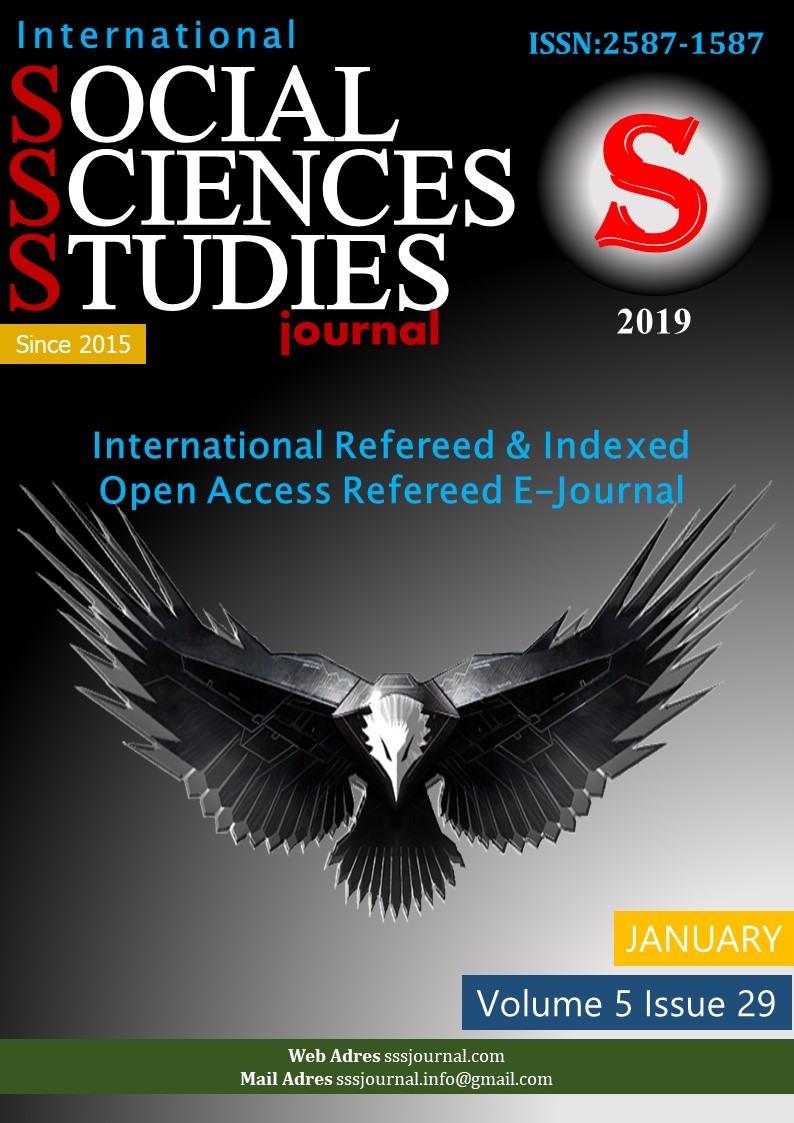Author :
Abstract
Bu araştırmada öğretmenlerin öğretim perspektiflerini incelemeyi sağlayan bir ölçme aracı olarak Daniel D. Pratt ve John B. Collins (2000) tarafından geliştirilen ve “Eylemler” “Niyetler” “İnanışlar”” boyutlarından oluşan 45 maddelik “Öğretim Perspektifleri Envanteri”ni Türkçeye uyarlamak ve uyarlanan envanter ile sınıf öğretmenlerinin öğretim perspektiflerini cinsiyet ve kıdem (hizmet yılı) bakımından incelemek amaçlanmıştır. Çalışmada nicel araştırma yöntemleri kullanılmıştır. Elde edilen verilerin analizinde SPSS 22 ve LISREL 8.80 programları kullanılmıştır. Öncelikle uzman bir grup tarafından yapılan çeviri aşaması gerçekleştirildikten sonra 108 anaokulu, ilkokul, ortaokul ve lise öğretmenine ilk uygulama yapılmış ve verilerin faktör analizi için uygunluğu incelenmiştir. Daha sonra ise envanterin faktör yapısı, doğrulayıcı faktör analizi ile test edilmiştir. 12 hafta sonra envanterin 108 öğretmene tekrar uygulanmasıyla, envanterin güvenirliğine ilişkin Pearson momentler çarpımı korelasyon katsayısı ve envanterin tamamı için Cronbach’s Alpha iç tutarlık katsayısı hesaplanmıştır. Elde edilen faktör yapısına doğrulayıcı faktör analizi uygulandığında elde edilen modelin doğrulandığı ve geçerli olduğu görülmüştür. Envanterin tamamı için Cronbach’s Alpha iç tutarlık katsayısı 0,871 olarak elde edilmiştir. Envanterin ilk ve ikinci uygulamaları arasındaki Pearson korelasyon katsayısı ise 0,999 olarak elde edilmiştir. Sonuç olarak envanterin Türkçe halinin geçerlik ve güvenirliği sağlanmıştır. Bu doğrultuda İstanbul ili Bağcılar ilçesinde 100 sınıf öğretmenine yapılan uygulama sonucunda öğretmenlerin envantere göre sahip olabileceği perspektifler (Aktarma, Yetiştirme, Geliştirme, Teşvik Etme ve Toplumsal Reform) incelendiğinde sınıf öğretmenlerinin %45’inde baskın öğretim perspektifi olarak “Teşvik etme” perspektifine sahip oldukları ortaya çıkmıştır. Sınıf öğretmenlerinin yalnızca %4’ünde ise “Geliştirme” öğretim perspektifinin baskın olduğu anlaşılmıştır. Bununla birlikte baskın öğretim perspektiflerinde cinsiyet ve kıdem (hizmet yılı) bazında anlamlı farklılık olduğu sonucuna ulaşılmıştır.
Keywords
Abstract
The present study attempts to produce the Turkish version of “Teaching Perspectives Inventory”, developed by Daniel D. Pratt and John B. Collins (2000), and to investigate teaching perspectives of elementary school teachers in terms of gender and professional seniority (length of service) with the adapted Turkish version. The inventory consists of 45 items, which are categorized into three domains, namely “Actions”, “Intentions” and “Beliefs”. Quantitative research methods were employed for the purpose of the study. SPSS 22 and LISREL 8.80 software programs were used to analyze the obtained data. Following the translation of the English version into Turkish by a group of specialists, it was administered to 108 kindergarten, elementary school, middle school, and high school teachers and then the suitability of the data for factor analysis was examined. Later on, the factor structure of the inventory was tested by confirmatory factor analysis. 12 weeks later, the inventory was re-administered to the 108 teachers to calculate Pearson’s Product Moment Correlation Coefficient to test its reliability and Cronbach’s Alpha internal consistency coefficient for the entire tool. The confirmatory factor analysis performed on the factor structure revealed that the model at stake was confirmed and valid. Cronbach’s Alpha internal consistency coefficient was calculated to be .871 for the whole inventory. On the other hand, Pearson’s correlation coefficient of the inventory was calculated to be .999 between the first and second administration. As a result, the reliability and validity of the Turkish version were confirmed. From the administration of the adapted inventory to 100 elementary school teachers in Bağcılar - Istanbul and the analyses of the perspectives (Transmission, Apprenticeship, Developmental, Nurturing, and Social Reform), it was concluded that the dominant teaching perspective of 45% of the elementary school teachers was “Nurturing”. It was also observed that only 4% adopted the “developmental” teaching perspective. Moreover, it was found out that dominant teaching perspectives significantly differed by gender and professional seniority (length of service).
Keywords
- Bakioğlu, A. & Yıldız, A. (2015). Pisa Bağlamında Finlandiya Eğitim Sistemi ve Öğretmen Eğitimi. Vize
- Bakioğlu, A. & Yıldız, A. (2015). Pisa Bağlamında Finlandiya Eğitim Sistemi ve Öğretmen Eğitimi. Vize yayıncılık, Ankara.
- Beijaard, D.; Meijer, P. C., & Verloop, N. (2004). “Reconsidering Research on Teachers’ Professional İdentity”, Teaching and Teacher Education, 20: 107–128.
- Borg, S. (2009). “English Language Teachers’ Conceptions of Research”. Applied Linguistics, 30(3): 358- 388.
- Büyüköztürk, Ş.; Kılıç Çakmak, E., Akgün, Ö.E., Karadeniz, Ş. & Demirel, F. (2008). Bilimsel Araştırma Yöntemleri (Onüçüncü baskı), Pegem Akademi Yayınları, Ankara.
- Çelikten, M.; Şanal, M., & Yeni, Y. (2005). “Öğretmenlik Mesleği ve Özellikleri”, Erciyes Üniversitesi Sosyal Bilimler Enstitüsü Dergisi, 19(2): 207-237.
- Gülbağcı Dede, H. & Akkoç, H. (2016). “Pedagojik Formasyon ve Eğitim Fakülteleri Lisans ProgramlarınaKatılan Matematik Öğretmeni Adaylarının Mesleki Kimliklerinin Karşılaştırılması”, Turkish Journal of Computer and Mathematics Education, 7(1): 188-206.
- Huball, H.; Collins, J.& Pratt, D. (2005). “Enhancing Reflective Teaching Practices İmplications for Faculty Development Programs”, The Canadian Journal of Higher Education, 35(3): 57-81.
- Karasar, N. (1999). Bilimsel Araştırma Yöntemi, Nobel Yayın Dağıtım, Ankara.
- Karakuş, M. (2001). “Eğitim Programlarında Eleştirel Düşünmeyi Geliştirmenin Bir Yolu Olarak BAV Etkinlikleri”, Çukurova Üniversitesi Sosyal Bilimler Enstitüsü Dergisi, 8(8): 219-237.
- Pajares, M. F. (1992). “Teachers’ Beliefs and Educational Research: Cleaning up a Messy Construct”, Review of Educational Research, 62(3): 307-332.
- Pratt, D.D. & Collins, J.B. (2000). The Teaching Perspectives İnventory: Developing and Testing anİnstrument to Asses Teaching Perspectives, Proceeding of the 41. Adult Education Research Confernce, Vancouver, B.C.
- Pratt, D.D. (2005). “Personal Philosophies of Teaching: A False Promise? ACADEME”, American Association of University Professors, 91(1): 32-36.
- Richardson, V. (1996). “The Role of Attitudes and Beliefs in Learning to Teach”. (In J. Sikula, T. J.Buttery & E. Guyton Eds.), Handbook of Research on Teacher Education, pp102-119, Macmillan, New York.
- Uştu, H.; Mentiş Taş, A. & Sever, B. (2016). “Öğretmenlerin Mesleki Gelişime Yönelik Algılarına İlişkin Nitel Bir Araştırma”, Electronic Journal of Occupational İmprovement and Research, 2016(1): 15–23.
- Whitty, G. (2005). “Moving Beyond Recent Education Reform – and Towards a DemocraticProfessionalizm”, Paper Presented at The International Symposium on Education Reform and Teachers, Hitotsubashi Univesity, Tokyo, Japan, November 2005.
- Yalçın, F. (2015). “A Crosscultural Study on Outdoor Play: Parent and Teacher Perspectives, theDepartment of Early Childhood Education”, Middle East Technical University, The Department of Early Chıldhood Educatıon, Yayımlanmamış Yüksek Lisans Tezi.
- Yıldırım, A., Ünal, A., Çelik, M. (2011). “Öğretmen Kavramına İlişkin Öğretmen, Yönetici ve Müfettiş Algılarının Analiz”i. Uluslararası İnsan Bilimleri Dergisi, 8(2): 92-109.
